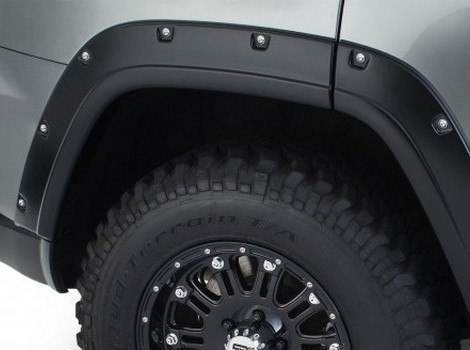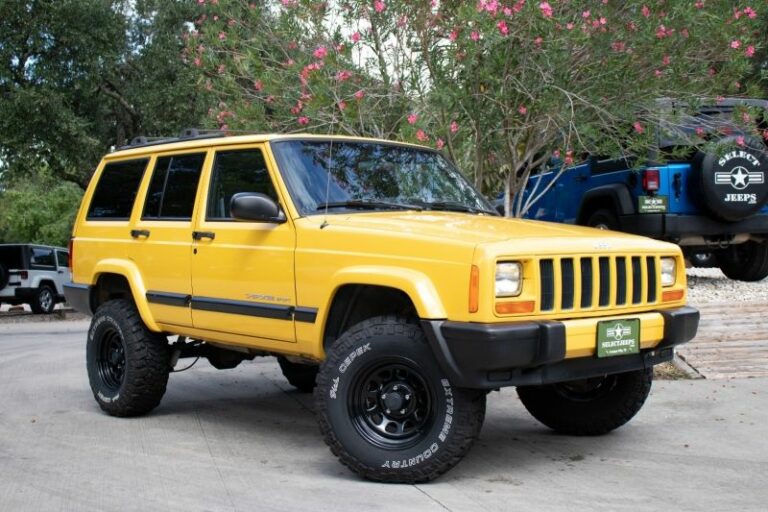2004 Jeep Grand Cherokee Fender Flares: Enhancing Your WJ’s Stance, Protection, and Style
2004 Jeep Grand Cherokee Fender Flares: Enhancing Your WJ’s Stance, Protection, and Style jeeps.truckstrend.com
The 2004 Jeep Grand Cherokee, part of the beloved WJ generation (1999-2004), remains a popular choice for both daily driving and off-road adventures. Renowned for its blend of comfort, capability, and classic Jeep styling, many owners seek to personalize and enhance their WJ’s performance and appearance. Among the most impactful modifications are fender flares. These seemingly simple additions play a crucial role in protecting your vehicle, complying with tire coverage laws, and dramatically altering your Grand Cherokee’s aesthetic, giving it a more aggressive, rugged, or custom look. Whether you’re upgrading to larger tires for improved off-road prowess or simply aiming for a bolder street presence, understanding the world of 2004 Jeep Grand Cherokee fender flares is essential for any WJ owner.
Why Consider Fender Flares for Your 2004 Grand Cherokee?
2004 Jeep Grand Cherokee Fender Flares: Enhancing Your WJ’s Stance, Protection, and Style
Beyond mere aesthetics, fender flares offer a suite of practical benefits that make them a worthwhile investment for any 2004 Grand Cherokee owner.
Aesthetic Enhancement
Stock 2004 Grand Cherokees come with modest, integrated fender trim. While functional, they don’t always convey the rugged spirit of a Jeep. Aftermarket fender flares, especially the wider, more pronounced styles, instantly transform the vehicle’s profile. They create a more aggressive, planted stance, making your WJ look more capable and custom. This visual upgrade is particularly striking when paired with larger wheels and tires, giving your Grand Cherokee a formidable presence on and off the road.
Off-Road Protection
If your 2004 Grand Cherokee sees dirt, mud, or rocky trails, fender flares are almost a necessity. Wider tires, especially those with aggressive treads, are notorious for kicking up debris. Without adequate coverage, mud, rocks, gravel, and other trail hazards can chip your paint, dent your body panels, and even shatter windows. Fender flares extend outward, providing a crucial barrier that deflects this debris, protecting your vehicle’s paintwork and preventing costly damage to the body.
Tire Coverage Compliance
Many states and municipalities have laws requiring vehicle tires to be fully covered by the fender or a flare. When you upgrade your 2004 Grand Cherokee with wider aftermarket tires or wheels with a more aggressive offset, the tires often extend beyond the factory fender line. This not only makes your vehicle prone to throwing debris but can also lead to fines or failed inspections. Fender flares are the primary solution to ensure your WJ remains compliant with these "tire poke" laws, allowing you to run wider tires legally and safely.
Rust Prevention

While not their primary function, fender flares can indirectly contribute to rust prevention. By shielding the exposed edges of your wheel wells and the lower body panels from direct impact and constant bombardment of road salt, mud, and water, they reduce the likelihood of paint chips and abrasions that can expose bare metal and lead to corrosion over time.
Types of Fender Flares for the 2004 Jeep Grand Cherokee (WJ)
The market offers a variety of fender flare styles, each catering to different aesthetic preferences and functional requirements for your 2004 Grand Cherokee.
- OEM-Style/Stock Replacement: These flares are designed to closely mimic or replace the factory flares. They offer a subtle extension, primarily for minor tire coverage or to replace damaged original components. They maintain a clean, understated look.
- Pocket-Style/Rivet-Style: Arguably the most popular choice for modified Grand Cherokees, these flares feature exposed "rivets" or bolts around the outer edge, giving them a rugged, bolt-on appearance. They typically provide significant additional tire coverage (2-3 inches or more) and are ideal for owners running large, wide tires. While the "rivets" are often decorative (simulated bolts), some require drilling into the fender for installation.
- Smooth/Street Style: These flares offer extended tire coverage without the prominent "pocket" look. They have a cleaner, more integrated design, flowing smoothly with the body lines. They are often chosen by those who want the functionality of wider flares but prefer a less aggressive, more refined aesthetic.
- Extended/OE-Style Plus: These are a hybrid, offering more coverage than stock but with a smooth, integrated appearance, similar to an OEM design but wider. They’re a good middle ground for those needing more coverage than stock but not wanting the bold look of pocket flares.

Materials: Most aftermarket fender flares for the 2004 Grand Cherokee are made from durable materials like:

- ABS Plastic: Lightweight, flexible, and resistant to impacts. Often UV-protected to prevent fading.
- DuraFlex 2000: A proprietary material (e.g., Bushwacker’s) known for its extreme durability, flexibility, and resistance to warping and cracking in various temperatures.
- Fiberglass: Less common due to its rigidity and susceptibility to cracking on impact, but sometimes used for custom applications.
Key Considerations Before Purchasing
Choosing the right fender flares for your 2004 Grand Cherokee involves more than just picking a style. Thoughtful consideration of these factors will ensure satisfaction.
- Tire Size and Offset: This is paramount. Measure how far your current or planned tires protrude beyond the factory fender. This measurement will directly dictate how much additional flare width you need. Most manufacturers list the added coverage (e.g., "adds 2 inches of coverage").
- Intended Use: Will your WJ be a pavement princess or a dedicated trail rig? For serious off-roading, maximum coverage and durable materials are key. For street use, aesthetics might take precedence.
- Installation Difficulty: Some flares are "no-drill" and attach using existing holes or clips, while others (especially pocket-style) may require drilling into your fenders. Assess your DIY comfort level or factor in professional installation costs.
- Budget: Fender flares vary widely in price based on brand, material, and style. Set a realistic budget before you start shopping.
- Local Regulations: Double-check your state or local laws regarding tire coverage. Some areas are stricter than others.
- Brand Reputation: Stick with reputable brands known for quality and fitment. Bushwacker, Rugged Ridge, Smittybilt, and EGR are among the leaders in the aftermarket fender flare industry for Jeep vehicles. Reading reviews specific to the 2004 Grand Cherokee (WJ) is highly recommended.
Installation Guide: Step-by-Step for Your 2004 Grand Cherokee
While specific instructions vary by manufacturer and flare type, here’s a general guide for installing fender flares on your 2004 Jeep Grand Cherokee:
Tools You Might Need:
- Socket wrench set (various sizes)
- Screwdriver set (Phillips and flathead)
- Drill and appropriate drill bits (if required for pocket style)
- Utility knife or trim removal tools
- Measuring tape
- Rubbing alcohol and clean cloth
- Masking tape
- Protective eyewear and gloves
Preparation:
- Clean the Area: Thoroughly wash and dry the fender and wheel well areas where the flares will be mounted. Remove any dirt, grime, or wax. Use rubbing alcohol for a final clean to ensure proper adhesion (if using adhesive strips).
- Remove Old Flares (if applicable): If your WJ has existing flares, carefully remove them. This usually involves unscrewing bolts from the wheel well liner and gently prying off clips.
- Test Fit: Before doing anything permanent, hold each flare in place to ensure it aligns correctly with the fender lines. Use masking tape to mark alignment points if needed.
Installation Steps (General):
- Attach Edge Trim: Many flares come with a rubber or plastic edge trim that needs to be installed along the inner lip of the flare. This protects your paint and provides a finished look.
- Mounting Brackets/Clips: Depending on the design, you may need to attach mounting brackets or clips to the inner side of the flare or to existing holes in the fender.
- Drilling (if necessary): For "pocket-style" flares that require drilling, carefully align the flare and mark the drill points. Use a small pilot bit first, then the recommended size. Always double-check your measurements and position before drilling.
- Secure the Flares:
- No-Drill: These usually utilize existing factory holes, clips, and/or automotive-grade double-sided tape. Press firmly along the adhesive strips to ensure a strong bond.
- Bolt-On/Rivet-Style: Fasten the flares using the provided hardware (bolts, nuts, washers). Ensure they are snug but do not overtighten, which can crack the flare or damage the fender.
- Repeat for All Four Fenders: Follow the same process for each wheel well.
- Final Checks: Once all flares are installed, inspect them to ensure they are securely mounted, flush with the body, and properly aligned.
Common Challenges & Tips:
- Alignment: Take your time. Misaligned flares will look off. Use masking tape for temporary positioning.
- Tight Fits: Sometimes the fit is very snug. A second pair of hands can be helpful.
- Drilling Confidence: If you’re hesitant about drilling into your vehicle, consider professional installation.
- Temperature: Install in a moderate temperature. Extreme cold can make plastic brittle, and extreme heat can affect adhesive performance.
Maintaining Your 2004 Grand Cherokee Fender Flares
Once installed, a little maintenance will keep your fender flares looking good and performing their job.
- Regular Cleaning: Wash your flares regularly, especially after off-roading, to remove mud, dirt, and road grime. Use a mild automotive soap and a soft brush or cloth.
- UV Protection: Plastic flares can fade and become brittle over time due to UV exposure. Use a UV protectant spray specifically designed for automotive plastics (e.g., 303 Aerospace Protectant) every few months. This will help maintain their original color and flexibility.
- Check Fasteners: Periodically check the mounting bolts or clips to ensure they are still tight, especially after heavy off-roading.
- Repair Minor Damage: Small scuffs or scratches can often be buffed out with plastic polish. For deeper gouges, some touch-up paints are available, or the flare might need replacement if severely damaged.
Table Price: 2004 Jeep Grand Cherokee Fender Flares
Here’s an estimated price guide for 2004 Jeep Grand Cherokee fender flares. Prices can vary significantly based on brand, style, material, and retailer. These are general ranges for a complete set of four flares.
| Flare Type/Style | Material | Added Coverage (Approx.) | Estimated Price Range (USD) | Key Features |
|---|---|---|---|---|
| OEM-Style/Stock | ABS Plastic | 0.5" – 1" | $150 – $300 | Direct replacement, subtle, clean look. |
| Smooth/Street Style | ABS Plastic, DuraFlex | 1.5" – 2.5" | $250 – $450 | Enhanced coverage, sleek, no visible hardware. |
| Pocket-Style | ABS Plastic, DuraFlex | 2" – 3"+ | $350 – $700 | Aggressive, bolt-on look, maximum coverage. |
| Extended OE-Style | ABS Plastic, DuraFlex | 1.5" – 2" | $300 – $550 | Wider than stock, integrated appearance. |
| Installation Cost | N/A | N/A | $150 – $400 (Professional) | Varies based on shop and complexity of install. |
Note: Prices are estimates and subject to change. Always check current retail prices from reputable vendors.
Frequently Asked Questions (FAQ)
Q1: Do I really need fender flares if I put bigger tires on my 2004 Grand Cherokee?
A1: It depends on how much wider or taller your new tires are and your local laws. If your tires protrude beyond the factory fender line, you likely need flares to comply with tire coverage laws and to protect your paint from debris.
Q2: Are 2004 Grand Cherokee fender flares difficult to install myself?
A2: It varies by flare type. "No-drill" flares are generally easy for a DIY enthusiast. "Pocket-style" flares that require drilling can be more challenging and intimidating. If you’re not comfortable drilling into your vehicle, professional installation is recommended.
Q3: What’s the best material for 2004 Grand Cherokee fender flares?
A3: ABS plastic and DuraFlex 2000 are excellent choices. DuraFlex (often proprietary to brands like Bushwacker) is known for superior durability and flexibility, making it highly resistant to impacts and extreme temperatures. ABS plastic is also very durable and widely used.
Q4: Will fender flares prevent rust on my 2004 Grand Cherokee?
A4: They don’t prevent rust entirely, but they can significantly reduce the risk by protecting the exposed paint and metal around the wheel wells from chips and abrasions caused by thrown debris, which are common starting points for rust.
Q5: Can I paint my fender flares to match my 2004 Grand Cherokee’s color?
A5: Yes, most ABS plastic and DuraFlex flares come in a matte black finish but can be prepped and painted to match your vehicle’s color. Consult a professional paint shop for the best results, as proper surface preparation is crucial for paint adhesion.
Q6: Do fender flares come in sets of 4, or do I buy them individually?
A6: Fender flares for the 2004 Grand Cherokee are almost always sold in complete sets of four (front driver, front passenger, rear driver, rear passenger).
Conclusion: Elevate Your WJ’s Potential
Fender flares for the 2004 Jeep Grand Cherokee are far more than just an aesthetic upgrade. They are a functional necessity for owners running larger tires, offering crucial protection against road debris and ensuring legal compliance. From the subtle, factory-like replacements to the bold, aggressive pocket-style flares, there’s a design to suit every taste and application. By carefully considering your needs, understanding the installation process, and choosing a reputable brand, you can transform your beloved WJ, enhancing its rugged appeal, protecting its finish, and ensuring it stands out on any terrain. Investing in the right fender flares is an investment in your 2004 Grand Cherokee’s longevity, capability, and undeniable presence.



